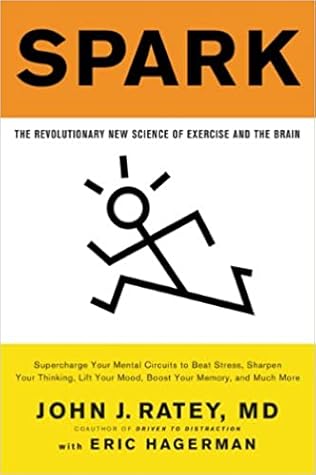More on this book
Community
Kindle Notes & Highlights
Read between
June 30, 2018 - January 7, 2019
neuron is like a tree that instead of leaves has synapses along its dendritic branches; eventually new branches sprout, providing more synapses to further solidify the connections. These changes are a form of cellular adaptation called synaptic plasticity, which is where BDNF takes center stage.
Certainly, we can speed up the decline, a point that your eighth-grade biology teacher may have made to scare you away from underage drinking. “Now, remember: alcohol kills brain cells, and they never grow back.” But guess what? They do grow back—by the thousands.
In this case, the radiation dose was apparently low enough that instead of killing the cells of the exposed workers, it made them stronger.
stress seems to have an effect on the brain similar to that of vaccines on the immune system. In limited doses, it causes brain cells to overcompensate and thus gird themselves against future demands. Neuroscientists call this phenomenon stress inoculation.
If you exercise or even just socialize, you’re tapping into the evolutionary antidote to stress.
mice and rats that are given a third of their normal calories live up to 40 percent longer than average.
With exercise, you gain a sense of mastery and self-confidence. As you develop awareness of your own ability to manage stress and not rely on negative coping mechanisms, you increase your ability to “snap out of it,” so to speak. You learn to trust that you can deal with it—an
But if you worry when there’s no real threat, to the point where you can’t function normally, that’s an anxiety disorder.
Anxiety is fear, but what is fear? In neurological terms, fear is the memory of danger.
In addition to feeling good when you exercise, you feel good about yourself, and that has a positive effect that can’t be traced to a particular chemical or area in the brain.
A massive Dutch study of 19,288 twins and their families published in 2006 showed that exercisers are less anxious, less depressed, less neurotic, and also more socially outgoing.
Sexual feelings and passions are primary drivers in all of us, and muzzling them can leave us with a general lack of passion for life or a lack of intimacy or maybe a list of missed opportunities.
every fifty minutes of weekly exercise correlated to a 50 percent drop in the odds of being depressed.
The shutdown in depression is a shutdown of learning at the cellular level. Not only is the brain locked into a negative loop of self-hate, but it also loses the flexibility to work its way out of the hole.
Psychiatrist Alexander Niculescu sees depression as a survival instinct to conserve resources in an environment void of hope—”to keep still and stay out of harm’s way,” he wrote in a 2005 article in Genome Biology. It’s a form of hibernation: When the emotional landscape turns wintry, our neurobiology tells us to stay inside.
“As an antidote, you’re giving the individual an avenue of life experience that most have not had—the goals of exercise, the feeling of exercise, the challenge of exercise, the pleasure and the pain, the accomplishment, the physical well-being, the self-esteem. All that exercise gives us, you’re now presenting to the addict as a very compelling option.”
“He’ll be next to me on the couch,” she says. “I’ll hear him breathing and be like, Do you have a sinus infection or something?”
“all we can do at the present time is modify the environmental factors to get the best out of whatever genes we have.”


